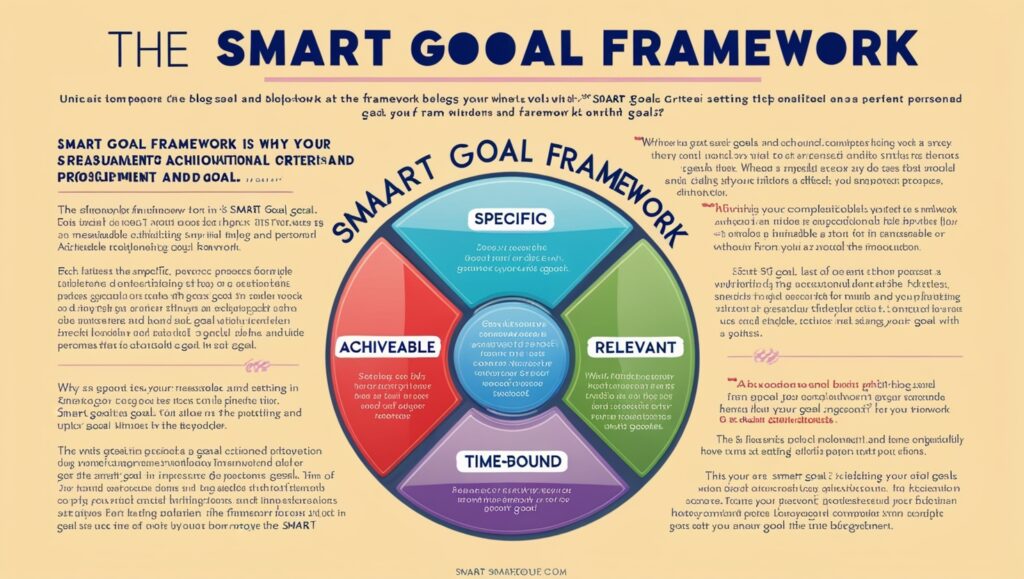The SMART Goal Framework How to Set Achievable Goals
Setting goals is a fundamental part of personal and professional development, but achieving them can often feel daunting. The SMART goal framework is a proven method for setting and reaching objectives effectively. It transforms vague ideas into actionable steps, providing clarity and direction. Let’s explore what SMART goals are, why they work, and how you can implement them to achieve your aspirations.
What Are SMART Goals?
The SMART framework is an acronym that stands for Specific, Measurable, Achievable, Relevant, and Time-bound. Each element ensures that your goal is well-defined and realistic, laying a clear path for success.
- Specific: The goal must be clear and unambiguous. Instead of saying, “I want to get healthier,” a more specific goal would be, “I will exercise for 30 minutes five days a week.”
- Measurable: Establish criteria to track progress. This helps you stay on course and recognize when you’ve met your target. For example, if your goal is to save money, set a measurable amount, like, “I will save $200 per month.”
- Achievable: While it’s good to aim high, your goal should be realistic given your current resources and time. If your aim is to start a new career, break it down into smaller, achievable steps, like completing a specific certification.
- Relevant: The goal should align with your broader life ambitions and priorities. Ask yourself, “Is this goal worthwhile?” If you’re looking to boost your career, a relevant goal might be, “I will learn a new skill that is in demand in my industry.”
- Time-bound: Set a deadline for your goal to instill a sense of urgency. A time frame such as “I will complete my certification within six months” helps maintain focus and motivation.
Why SMART Goals Work
SMART goals work because they convert ambitions into clear action plans. They break down overwhelming tasks into manageable steps, ensuring that each part of the process is aligned with your capabilities. This framework helps maintain motivation by celebrating small milestones, making it easier to stay committed.
How to Implement the SMART Goal Framework
1. Start with a Clear Vision
Think about what you truly want to achieve, whether it’s personal growth, career development, financial stability, or health improvement. Visualize your end result and write it down.
Example: You want to become more fit. Your initial thought might be “I want to lose weight,” but this is vague. With the SMART framework, you can specify it as, “I want to lose 15 pounds by exercising for 45 minutes, five times a week, and following a balanced diet for three months.”
2. Break Down the Goal into SMART Components
Now, take that vision and make it SMART:
- Specific: “I will lose 15 pounds.”
- Measurable: “I will track my weight loss weekly.”
- Achievable: “I will exercise 45 minutes, five days a week, which is manageable with my current schedule.”
- Relevant: “This goal is relevant because improving my health will increase my energy and well-being.”
- Time-bound: “I will achieve this in three months
3. Create an Action Plan
An action plan outlines the steps needed to achieve your goal. For example, in the weight loss scenario, your plan might include:
- Scheduling workouts at the beginning of each week.
- Preparing healthy meals in advance.
- Tracking calories or joining a fitness app.
4. Monitor and Adjust
Regularly review your progress to see if you’re on track. If you’re not meeting your milestones, don’t get discouraged—adjust your action plan as needed.
Example: If you’re unable to commit to 45 minutes a day, reduce it to 30 minutes but increase the intensity of the workout.
Real-Life Examples of SMART Goals
Example 1: Career Advancement
- Specific: “I will complete a project management course.”
- Measurable: “I will track my completion by finishing modules weekly.”
- Achievable: “The course requires 5 hours a week, which I can manage.”
- Relevant: “Project management skills will help me qualify for a promotion.”
- Time-bound: “I will complete the course in four months.”
Example 2: Financial Goal
- Specific: “I will save for a vacation.”
- Measurable: “I will save $300 each month.”
- Achievable: “Cutting back on dining out will free up $300 monthly.”
- Relevant: “This goal is relevant to my desire for relaxation and travel.”
- Time-bound: “I will have the necessary amount in six months.
Tips for Staying on Track
Keep Your Goals Visible: Write your SMART goals on a board or in a journal.
Stay Flexible: Life happens, so be prepared to adjust your plan.
Celebrate Small Wins: Reward yourself for reaching mini-milestones.
Final Thoughts
The SMART goal framework helps you turn your ideas into clear, actionable plans. By following this method, you can set realistic and motivating goals, paving the way to personal and professional success. Start small, stay consistent, and watch how your confidence grows as you achieve each goal.

